My most recent Z4 tour started with the top of a mountain, a sudden rainstorm, and two new friends, and it ended with a world-class collection of BMW motorcycles and automobiles. In-between were some of the most interesting and beautiful sights I've seen on any of my GS and Z4 trips. Continue on, faithful readers, and see if you agree…
The overall goal was to get to Cape Cod in 2 days, by proceeding up the Hudson River as closely as possible until reaching Saratoga Springs. Conveniently, the May/June 2013 issue of
RoadRunner Magazine had just such a tour. Actually, I used only a portion of their route, which is described at
Hudson River Valley: America's Rhine River. With a few modifications, I had my GPS route all set.
My first stop wasn't scheduled, but I spotted this historic train station in Tuxedo, New York and had to take a look. The building was constructed in 1885 and received a thorough renovation in 2009. It originally served the wealthy residents of Tuxedo Park, which was a vacation and hunting resort for people from New York City. The name "Tuxedo," incidentally, comes from the Lenape Indian word "Tucseto," which means "place of the bear." Or, depending on whom you believe, "clear flowing water." (I report, you decide.)

And, yes, it's still a working railroad station, with numerous trains daily to Secaucus Junction and Hobocken, allowing an easy transfer to Penn Station in downtown New York. (I don't know if this damsel was rushing to escape a suspicious roving photographer or the ominous-looking conductor. I'm willing to assume that she just wanted to catch the train.)

I reached the official start of my tour at 12:45—only to discover that Lake Kanawauke Road was closed for repairs. That necessitated a lengthy detour on Seven Lakes Road, which turned out not to be a bad thing at all, as suggested by this photo of Lake Tiorati. (The lake's beach and swimming area were also closed for repairs. Go figure…) Moreover, it was a beautiful day for top-down BMW driving.


The park at Bear Mountain has entertained visitors since 1913. I have it on good authority that these nattily dressed folks were the very first people to ever explore the park (and that they enjoyed hiking in their Sunday-dinner clothes).

Remember the hapless railroad employee in "Butch Cassidy and the Sundance Kid," the one who refused to open the door of the railroad car and kept saying "I work for Mr. E.H. Harriman of the Union Pacific Railroad…"? Well, E.H.'s widow, Mary Averell Harriman, negotiated the deal to create the state park and donated a substantial portion of the land for it. Without her philanthropic efforts, Bear Mountain State Park would instead have become Bear Mountain Prison.
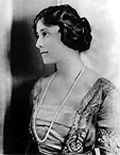
The Bear Mountain Inn has recently undergone a 5-year renovation, although it looks largely unchanged compared to these historic photos. I guess it was a lot of work to get rid of the ivy vines. Note the earlier forms of transportation. Nowadays, anyone can drive right up to the inn—even suspicious-looking photographers.



Back in 1913, everyone came to the park on steam cruisers from New York City. The fastest steamboat on the Hudson was the 1864 Chauncey Vibbard, which set a record in 1876 of 6 hours and 20 minutes from NYC to Albany. As best I can determine, that record still stands for commercial passenger vessels.

However, one of the most popular ships to Bear Mountain was the DeWitt Clinton, named for the sixth governor of New York. It originally served as a U.S. Navy transport and was notable for carrying British soldiers across the English Channel during World War I. The Great Depression ended the DeWitt Clinton's service as an excursion boat, and she found herself once again transporting troops across the English Channel during World War II. Following that war, she was steathily pressed into service to take Jewish refugees to their new home in Israel, apparently much to the displeasure of various U.S. and European government officials. No one knows what ultimately happened to this historic ship.
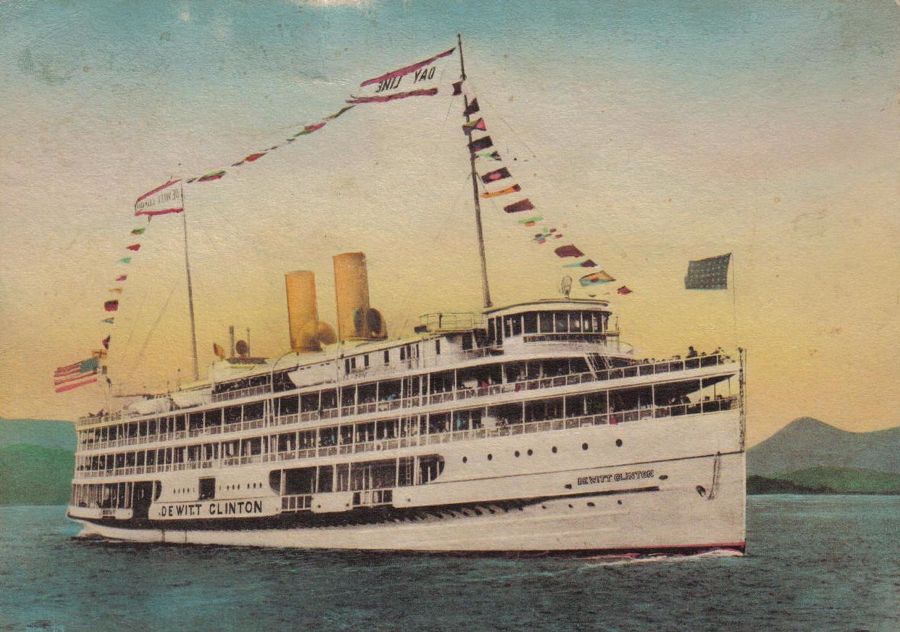
I reached the summit of Bear Mountain and promptly found evidence that I'm not the only one who reads
RoadRunner Magazine.

The top of Perkins Tower offered a great view of the surrounding countryside, not to mention the dark clouds that were rolling in.

As I meandered around the mountaintop, I soon bumped into an ebullient Italian (is there any other kind?) named Michele and a charming post-doc graduate student named Alina. The three of us struck up quite an interesting conversation, with elements of English, French, Italian, and Russian. Alina took this photo of Michele and me, with the Hudson River in the background. Michele is a businessman, who has been a U.S. resident for several decades. He had returned to Bear Mountain for the first time since he was a young man.

Alina is originally from Russia, and she has a Ph.D. in one of the most esoteric branches of Chemistry that you can imagine. She was on her way to a conference and stopped at Bear Mountain to do some sightseeing. Here she is, perched on one of the wooden benches that offer a relaxing view of the valley.

Minutes later, the rain began falling in earnest. We quickly traded email addresses, and then we went our separate ways. I managed to get another couple of photos from under an umbrella before driving back down the mountain. This is Iona Island in the Hudson. Native Americans lived here for hundreds of years before selling the island to Dutch settlers in 1683. By the late 1800s, the island had an amusement park, restaurants, a hotel, and a steamship dock. Then in 1900, Iona became a Navy munitions dump; the several buildings visible in the photo are all that's left of the original 164 facilities. Iona Island is now owned by the Pallisades Interstate Parks Commission but is off-limits to the public. The railroad tracks crossing the island are still active, much to the probable disgust of the resident Bald Eagles.

The Bear Mountain Bridge began operations in 1924 and allowed direct automobile access to the park (much to the financial distress of the steamship companies). The historical photo shows the last portion of the bridge being built. At that time, it was the longest suspension bridge, and the first to have a concrete deck, in the
world. Although the bridge strikes me as very scenic, the
New York Times ran an editorial in 1924 calling it "an infliction of ugliness on the Hudson."

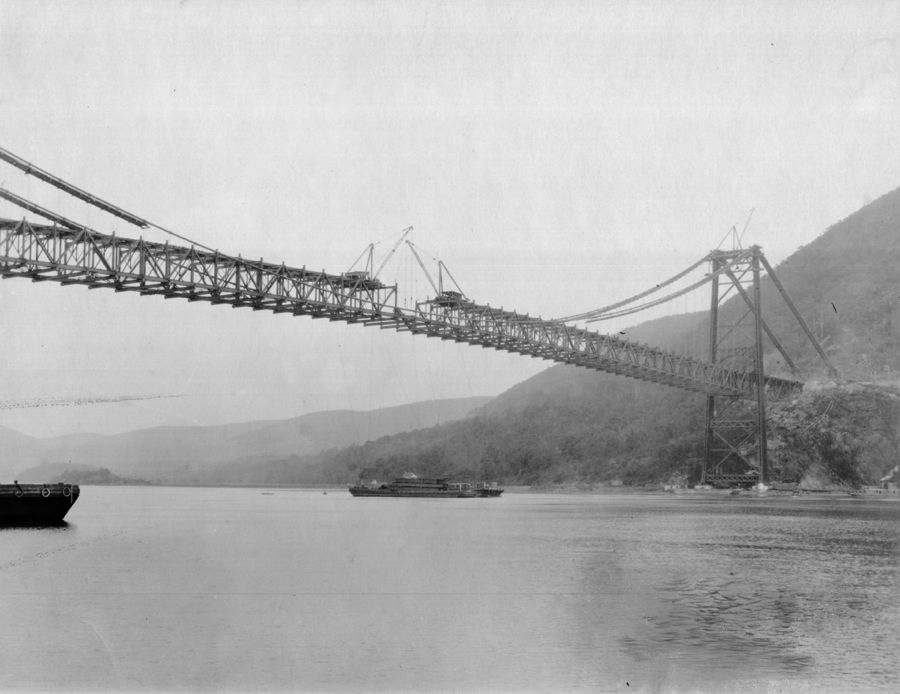
When I'd parked the Z4 on top of Bear Mountain, I'd put the top up for security, since I knew I'd be venturing some distance from the car. I needn't have worried about theft or vandalism, given the friendly and like-minded group of tourists on hand, but it proved to be a godsend when the rains came. In fact, it continued to rain and shine, back and forth, for the rest of the day. As soon as the top would dry, down it would go—only to come back up quickly during the next shower.

My faithful Canon SX10 camera, however, does not have a convertible top. While I was taking this photo of St. Mark's Chapel, a local resident named Melissa wandered over and volunteered to hold my umbrella for me. Very thoughtful! St. Mark's was built in 1923 in the town of Fort Montgomery, in anticipation of an influx of visitors to the nearby state park once the Bear Mountain Bridge was finished.

Melissa also told me about some nearby trails with interesting historical artifacts. They turned out to be the site of the west redoubt (an entrenched fortification) of the original 1776 Fort Montgomery! Not much was left, but it was a fun hike. Fort Montgomery, and the nearby Fort Clinton, were among the first fortifications built by the Continental Army during the American Revolution, with the goal of controlling ship traffic on the Hudson River.
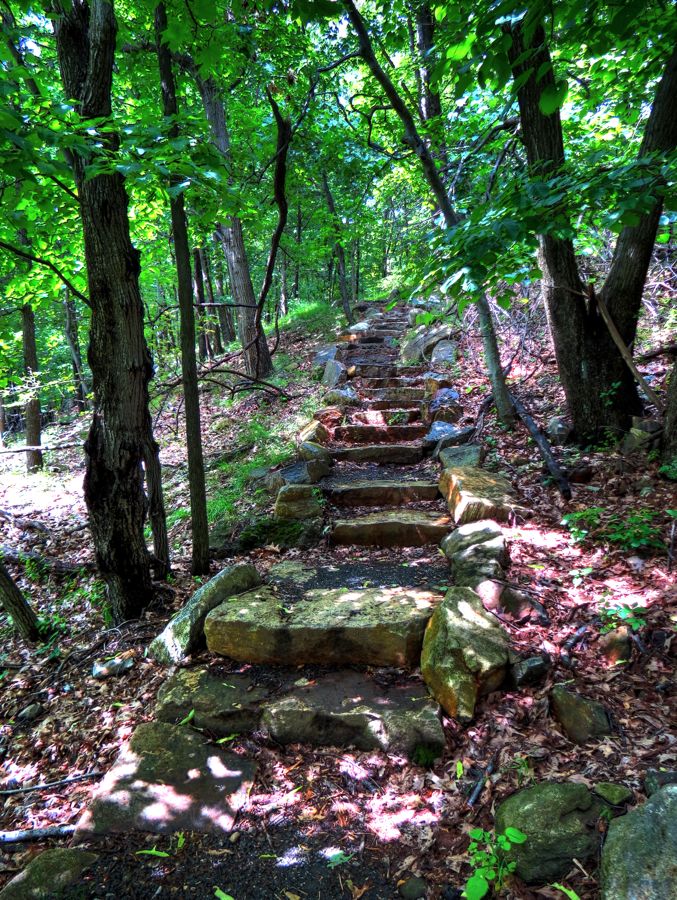
Forts Montgomery and Clinton played an important role in the Revolutionary War. On October 6, 1777, 2,000 British troops attacked the 600 colonial soldiers stationed there, moving in from the non-river side, where the forts' defenses were the weakest. The British also had support from Navy bombardments. Ultimately, they drove the colonial forces from the two forts, both of which were then destroyed. Roughly half of the Americans were killed, wounded, or captured. However… the diversion of British forces for this battle resulted in a stunning victory by the Continental Army at Saratoga, where General John Burgoyne had to surrender all 6,000 of his surviving troops. His surrender turned the tide of war in favor of the colonials, and the rest is, well, history. (Photo of battle reenactment courtesy of the Visitor Center's video, "
Battle of Fort Montgomery.")

My hike also led me directly beneath the Route 9W bridge over Popolopen Creek. It looked a bit spindly from my vantage point, but scenic nonetheless.

Back on the road, I soon discovered that an anticipated highlight of the tour—the Storm King Highway, running from West Point to Newburgh along the Hudson—was closed for repair! The historic 1916 road offers some of the best views of the river anywhere. Sigh… I'll content myself for now with this historic postcard. Fortunately, my longish detour also offered some dramatic vistas such as the one below. The buildings on the right are part of the West Point complex. (Postcard courtesy of
History of Storm King Highway, which tells the amazing story of how this road was carved into the side of the mountain.)


The village of Cornwall-on-Hudson lies just south of Newburgh. Such diverse individuals as British writer Amelia Barr, custom bike builder "Indian Larry," and General David Petraeus lived here at one time or another. I was looking for the 1826 Canterbury Presbyterian Church but managed to mistakenly find the 1858 St. John's Episcopal Church instead (

).

Fortunately, I correctly located the Sands Ring Homestead, which was built in 1760 by Nathaniel Sands and served as one of the earliest meeting places for Quakers in this part of New York. Since 1950, it's been a museum of colonial history.

Cornwall-on-Hudson also offered an opportunity to spot Pollepel Island, home to the ruins of Bannerman's Castle. On my visit, however, I learned three things: First, the Hudson River is very wide at this spot; second, that the island is on the far side of the river; and third, that the castle is on the far side of the island. So I looked in vain for quite a while.

If I had been able to see the castle, it would have looked like the photo below (courtesy of James Dunham on Flickr). After the Civil War, Scottish immigrant Frances Bannerman VI bought a huge amount of war-surplus arms, munitions, and other military equipment and started one of the first Army-Navy surplus businesses in the country. By 1900, he needed a place to store it all, as it would no longer fit in his downtown New York City warehouse. (Moreover, his warehouse held 30 million rifle cartridges, which the city frowned upon for some reason…) Bannerman bought Pollepel Island and built a huge, castle-like arsenal there.

In addition, Bannerman built a smaller castle home on top of the island. Sadly, both castles have been abandoned since 1950 and have been deteriorating steadily, with only the walls still standing. The main arsenal was badly damaged by fire in 1969, and the winter of 2009-2010 brought down large parts of both the arsenal and castle. I suspect the days are numbered for the rest, although the Bannerman Castle Trust is doing its best to stabilize the ruins. (Before and after photos courtesy of Dan "zeno 108" and Garrett S. Ziegler, respectively, on Flickr.)
.jpg)

The St. Thomas Episcopal Church has graced the banks of the Hudson River since 1848 (with a congregation dating back to 1728). It's notable for being the first Medieval Gothic church in the United States and for its stained glass windows, one of which is by Tiffany.

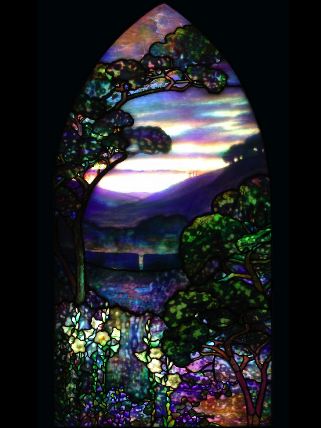
I'd stayed overnight in Newburgh while traveling to Cape Cod last year and fell in love with its history and architecture. I passed on through this year, taking just enough time to photograph this interesting pair of front steps. No cookie-cutter designs in this town.

I also looked for the historic David Crawford House, but an inexplicable case of Major Ineptitude landed me half a block short and on the wrong side of the street. I was sure that this mansion was the right place… Well, there's always
next year!

After recrossing the Hudson to its eastern shore, I somehow managed to find the village of Fishkill on the first try and the First Reformed Protestant Dutch Church on the second try. The church was founded in 1716, and the current building was constructed in about 1784, in part using the stone walls of the original church.

With fingers tightly crossed, I next set off on the 23-mile trip to Millbrook, NY, hoping that my destination would still be there… Specifically, I wanted to find the 200-room Halcyon Hall, which was built in 1893 as a resort hotel and soon after became the main campus building of Bennett College serving as such for nearly 90 years. The women's college had gone bankrupt in 1978, and Halcyon Hall had been vacant ever since. Weather and vandals had caused substantial deterioration over the years, and the county had scheduled Halcyon for
demolition in 2012, to make way for condominiums. Would it still exist?
I had carefully figured out a good photographic vantage point when planning the trip. When I arrived, I was ecstatic to see glimpses of the old building through the trees. It was still there! However, my path to the other side of the trees was blocked by a narrow but deep stream.

With the help of my somnambulant Zumo GPS, I managed to drive right up to the old entrance, only to find a chain-link fence, a locked gate, and several obvious "No Trespassing" signs.

Figuring that anything outside of the fence was fair game, I set off on foot to circumnavigate the property and arrive at the front of Halcyon Hall. Along the way, I discovered a neatly flattened section of the fence, presumably trampled by Fervent Explorers, and I was mightily tempted to wander on in. But my goal was a photograph of the building's full exterior. (If you'd like to see the inside, check out
Hudson Valley Ruins. It's something!) Soon enough, I found several good exterior vantage points, with the following results.


Halcyon Hall is in pretty bad shape, and one of the dormer sections has collapsed altogether in recent years. Town preservationists succeeded in their efforts to have the hall listed in the National Registry of Historic Places, but the county has sold the property rights to a condominium developer. The recent recession has put a damper on those plans; let's hope the preservationists will win out in the end. Here are a few photos from Bennett College in the early 1900s (courtesy of the
Hudson River Valley Heritage and the Millbrook Free Library). If you want to see this fascinating old building, I suggest that you go soon.







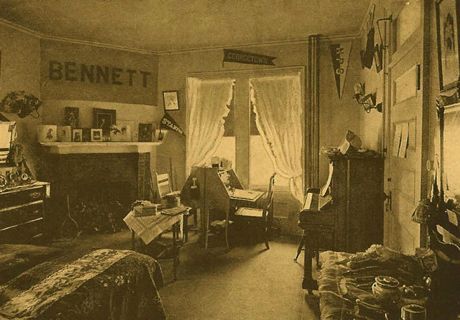
In the last pair of photos above, incidentally, it appears to be either the exact same room or very similar ones—the first one in its original hotel configuration, and the second as a typical dorm room for the college.
As fabulous as this first day of my tour had been so far, there was still more to come. This rural setting along Fallkill Creek was nice enough…

…and it was all the better given that the house in the distance was Eleanor Roosevelt's "Stone Cottage" on her Val-Kill retreat. Her close friends Nancy Cook and Marion Dickerman lived here from 1925 to 1947.

This is the actual Val-Kill home, which the First Lady used as her retreat from the rigors of public life. It started out as a furniture factory, designed by Mrs. Roosevelt to provide training and jobs for local men and women who could no longer make a living as farmers. The venture failed during the Great Depression, and she had it converted into a modest home. Following Franklin Roosevelt's death, Eleanor lived here for the rest of her life—in the process hosting many dignitaries. Winston Churchill had dinner here, sitting by the outdoor fireplace.

I have it on good authority that this friendly fellow is a direct descendant of Mrs. Roosevelt's own beloved pet chipmunk, "Mr. Chips." It's also possible that I made this part up.


The Roosevelts' formal home was the Springwood estate in Hyde Park, NY. FDR was born at Springwood and lived his whole life here, excluding his White House years. It was built around an 1800 farmhouse and expanded significantly in 1845, again in 1866 when FDR's father, James Roosevelt, bought the estate, and a final time in 1915 by FDR and his mother. Springwood is open for public tours, although not if you arrive at 7:00 PM, as I did!

Franklin and Eleanor Roosevelt are buried together in their rose garden, near the mansion.


James Roosevelt's horse stable is still in fine condition. I didn't see any horses through the window, but check out the collection of race ribbons on the left.

I happened across this place as I was driving down to the Hudson to get a look at the old Hyde Park railroad station. I had no idea what it was, but subsequent sleuthing identified it as the coach house for Frederick and Louise Vanderbilt's nearby estate. The noble BMW Z4 seems to fit right into the posh setting, wouldn't you agree?

The sound of falling water drew me to a nearby waterfall. This is only about one-third of it. The total vertical drop was so great that I couldn't find any way to reach the bottom level for a better photo.

Eventually I actually made it to the Hyde Park Station. Through the doors of this relatively plain depot passed the Roosevelts, the Vanderbilts, British King George VI and Queen Elizabeth, and many other dignitaries. President Roosevelt made his final trip here after his death, when his body was returned to Springwood for burial.

By now it was approaching 8:00 PM, and I had little hope that the Vanderbilt estate would still be open. It was, however, as long as the sun hadn't set completely, so my luck held out yet again! Approaching on the long driveway, I was struck by the ornate beauty of the mansion—it would have fit right into the Loire Valley in France.

A closer look confirmed the extraordinary elegance and beautiful design. I'll return one day for a proper tour. In the meantime, the historic photos below are courtesy of the National Park Service. The land had been owned by various others, including John Jacob Astor, dating back to 1764; the Vanderbilts purchased it in 1895, and the mansion was finished by 1899. Frederick Vanderbilt ran the New York Central Railroad for 61 years, amassing an enormous fortune in the process. His own railroad could whisk him comfortably from Hyde Park to New York City and back whenever he liked.



From the grounds of the Vanderbilt mansion, I could look across the Hudson and see what looked like another stately mansion. Zooming in, I discovered that it was more church-like in nature, and I later learned that this is the Holy Cross Benedictine Monastery and guesthouse, in West Park, NY. It has been training monks, ministering to the spiritual needs of visitors, and manufacturing incense ever since 1904.

I could also see that the sun was setting and more rain looked to be on the way. It was 8:30 PM, I had not arranged any place to stay that night, and I had skipped lunch and dinner in the tenacious pursuit of touring adventure. After considering these circumstances, naturally I decided to continue touring! (In fairness, I did take 2 minutes for the ever-helpful Siri to find an historic inn in nearby Rhinebeck; I booked their very last room, no doubt with minutes to spare.)


As I searched for the entrance to the Mills Mansion in Staatsburgh, NY, I couldn't help noticing a substantial amount of construction equipment and supplies. Thankfully, the Staatsburgh State Historical Site was open until sundown (another 10 minutes, at best), despite the repairs. The original part of the mansion was built in about 1832, and Ruth Livingston Mills and her husband Ogden expanded it in 1895 to its current size of 65 rooms, 14 bathrooms, and 23 fireplaces. The Mills lived in this mansion each Fall. They divided their time between four other, equally grand dwellings for the rest of the year. This is the back of the house, incidentally. The front is even nicer.

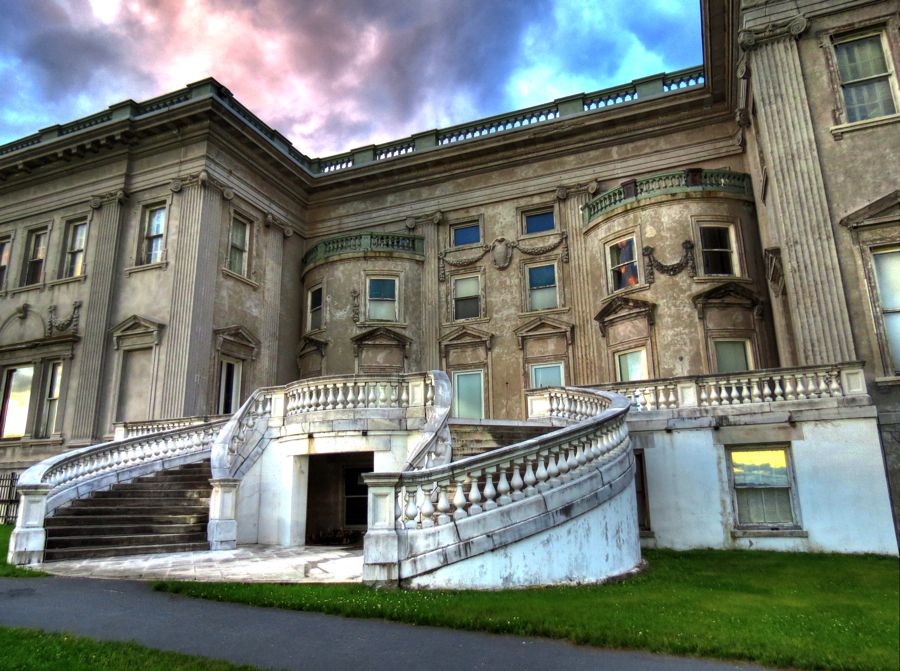

These two photos (courtesy of
HISTORYonics' terrific website) illustrate the interior of the Mills Mansion. Those dining room walls are made of marble, in case you were wondering. Some of the rooms were modeled after the most luxurious staterooms of the ocean liner
Titanic. Ruth and Ogden had actually booked passage for the Titanic's return trip from New York to Southampton in England. That voyage, of course, was never to be.


With a last look at the glorious sky, and my elegant parking space, it was time for a mad dash to Rhinebeck.


Naturally, the Saint Margaret of Antioch Church merited a photograph.

In Rhinebeck, my not-so-trusty Zumo woke up long enough to help me find the Beekman Arms Inn. Their dining room had just closed, but the very helpful staff suggested I try the Terrapin Restaurant, which turned out to be housed in this former church. They were open until 10:00 PM, and their duck and guacamole quesadilla was superb. Best of all, I met Jason and his wife (whose name I have unfortunately forgotten), who were sitting at the next table. In the course of an extended, very interesting conversation, they told me about yet another mansion nearby—abandoned in 1950 and now in ruins. Was my day complete or what?

My room at the Beekman Arms was probably not a lot different from what George Washington, Aaron Burr, Alexander Hamilton, Horace Greeley, William Jennings Bryan, Benjamin Harrison, Thomas Wolfe, Franklin D. Roosevelt, or any of the Inn's other notable guesets might have experienced when they stayed here back in the days. Other than the window air conditioner, modern bathroom, and free Wi-Fi, I suppose… (By the way, it is said that the quarrels between Burr and Hamilton, which ultimately led to the duel in which Hamilton was killed, originated in the Beekman Arms.) If you like classic old hotels, then this is the place for you. A call home and a quick scan of emails, and it was lights out.
